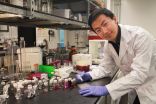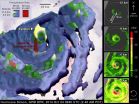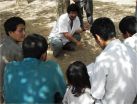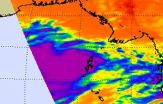Drug-infused nanoparticle is right for sore eyes
2014-10-08
(Press-News.org) For the millions of sufferers of dry eye syndrome, their only recourse to easing the painful condition is to use drug-laced eye drops three times a day. Now, researchers from the University of Waterloo have developed a topical solution containing nanoparticles that will combat dry eye syndrome with only one application a week.
The eye drops progressively deliver the right amount of drug-infused nanoparticles to the surface of the eyeball over a period of five days before the body absorbs them. One weekly dose replaces 15 or more to treat the pain and irritation of dry eyes.
The nanoparticles, about 1/1000th the width of a human hair, stick harmlessly to the eye's surface and use only five per cent of drug normally required.
"You can't tell the difference between these nanoparticle eye drops and water," said Shengyan (Sandy) Liu, a PhD candidate at Waterloo's Faculty of Engineering, who led the team of researchers from the Department of Chemical Engineering and the Centre for Contact Lens Research. "There's no irritation to the eye."
Dry eye syndrome is a more common ailment for people over the age of 50 and may eventually lead to eye damage. More than six per cent of people in the U.S. have it. Currently, patients must frequently apply the medicine three times a day because of the eye's ability to self-cleanse—a process that washes away 95 per cent of the drug.
"I knew that if we focused on infusing biocompatible nanoparticles with Cyclosporine A, the drug in the eye drops, and make them stick to the eyeball without irritation for longer periods of time, it would also save patients time and reduce the possibility of toxic exposure due to excessive use of eye drops," said Liu.
The research team is now focusing on preparing the nanoparticle eye drops for clinical trials with the hope that this nanoparticle therapy could reach the shelves of drugstores within five years.
INFORMATION:
Liu's research article, co-authored by eight others including Professors Frank Gu and Lyndon Jones, recently appeared in Nano Research, the leading publication on nanotechnology and nanoscience. The Natural Sciences and Engineering Research Council of Canada (NSERC) and 20/20: Ophthalmic Materials Network supported the research.
[Attachments] See images for this press release:

ELSE PRESS RELEASES FROM THIS DATE:
2014-10-08
The opening of a community court in a high-crime area of San Francisco was associated with a lower chance that offenders would be arrested for another crime within a year, according to a new RAND Corporation study.
San Francisco opened the Community Justice Center in 2009 to serve the city's Tenderloin district and adjacent neighborhoods. RAND researchers examined whether the Community Justice Center reduces the risk of rearrest when compared to more-traditional approaches for addressing arrestees.
San Francisco's Community Justice Center is a multifaceted intervention ...
2014-10-08
Hurricane Simon appeared to be keeping a secret before it rapidly intensified on Oct. 4, but the Global Precipitation Measurement or GPM satellite was able uncover it.
On Oct. 4 at 0940 UTC (5:40 a.m. EDT) observations by the Ku-band radar on the GPM satellite suggested that the Eastern Pacific Ocean's Hurricane Simon was hiding a very compact eyewall hours before the National Hurricane Center detected rapid intensification of Simon's surface winds. The GPM satellite was launched in February of this year and is managed by both NASA and the Japan Aerospace Exploration ...
2014-10-08
A new study from the University of Utah confirms that substantial numbers of teens are sexting – sending and receiving explicit sexual images via cellphone. Though the behavior is widely studied, the potentially serious consequences of the practice led the researchers to more accurately measure how frequently teens are choosing to put themselves at risk in this fashion.
The study surveyed 1,130 undergraduate students about their experiences sexting in high school. Nearly 20 percent reported they had sent a nude photo of themselves to another via cellphone and 38 ...
2014-10-08
Two NASA satellites provided data on clouds, rainfall and the diameter of the eye of Super Typhoon Vongfong as it turned north in the Northwestern Pacific Ocean.
Typhoon Vongfong formed on October 2, 2014 southeast of Guam. Typhoon Phanfone, that recently pummeled Japan, formed near the same area in the western Pacific Ocean.
Vongfong had wind speeds of about 120 knots (138 mph) when the Tropical Rainfall Measuring Mission or TRMM satellite flew above the intensifying typhoon's eye on October 7, 2014 at 0800 UTC (4 a.m. EDT). TRMM's Precipitation Radar (PR) showed that ...
2014-10-08
WASHINGTON, DC – October 8, 2014 - Elephants are among the most intelligent non-humans, arguably on par with chimps, but both African and Asian elephants—separate species—are endangered. In 1995, 16-month old Kumari, the first Asian elephant born at the National Zoo in Washington, DC, died of a then-mysterious illness. In 1999, Gary Hayward of Johns Hopkins University and collaborators published their results identifying a novel herpesvirus, EEHV1 as the cause of Kumari's sudden death. They now show that severe cases like this one are caused by viruses ...
2014-10-08
ST. LOUIS, MO – OCTOBER 8, 2014 – What could the natural diversity and beauty of plant leaves have in common with one of mankind's greatest creative inventions, the violin? Much more than you might imagine.
"There are many parallels between leaves and violins," says Dan Chitwood, Ph.D., assistant member, Donald Danforth Plant Science Center in St. Louis, Missouri. "Both have beautiful shapes that are potentially functional, change over time, or result from mimicry. Shape is information that can tell us a story. Just as evolutionary changes in leaf shape inform ...
2014-10-08
Gamma rays are the highest-energy form of radioactive waves known in the universe. However, how they're made and where they come from have been a bit of a mystery.
But now a team of researchers, led by Michigan State University astronomer Laura Chomiuk, has made a discovery that may shed some light on the subject.
Using highly detailed radio telescope images, Chomiuk and her team have pinpointed the location where an explosion on the surface of a star, known as a nova, emitted gamma rays.
This, said Chomiuk, is something they did not expect to encounter.
"We not ...
2014-10-08
In western society, where keeping up with the Joneses — or, better yet, surpassing them — is expected and even encouraged, status matters. So important is it that for many people, physical and emotional wellbeing are directly connected to their place in the social hierarchy.
That's hardly news to anthropologists at UC Santa Barbara, but they were taken by surprise when research findings indicated that the same relationship exists among the Tsimane, an egalitarian society of forager-farmers in the Bolivian Amazon. Their work is published online in the journal ...
2014-10-08
The Northern Indian Ocean has awakened after a tropical slumber and created Tropical Storm Hudhud on Oct. 8 and NASA's Aqua satellite passed overhead.
The Atmospheric Infrared Sounder or AIRS instrument that flies aboard NASA's Aqua satellite passed over Tropical Cyclone Hudhud on Oct. 8 at 6:53 UTC (2:53 a.m. EDT and captured infrared data on the storm revealing bands of strong thunderstorms around the center.
Animated infrared satellite imagery showed that the low-level circulation center was consolidating, and there is an improvement in the banding of thunderstorms ...
2014-10-08
TORONTO, October 7, 2014 – Health technology company Infonaut, a MaRS client, has released a study showing that hospital patients may be at significant risk of infection due to their own poor hand hygiene. The findings were measured in a Toronto hospital using Infonaut's Hospital Watch Live™ system, innovative technology designed to assist hospitals in monitoring and controlling the spread of infections by analyzing the movement and behaviour of hospital staff, patients and equipment.
The study found that patients on average washed their hands only 30% of the time ...
LAST 30 PRESS RELEASES:
[Press-News.org] Drug-infused nanoparticle is right for sore eyes







